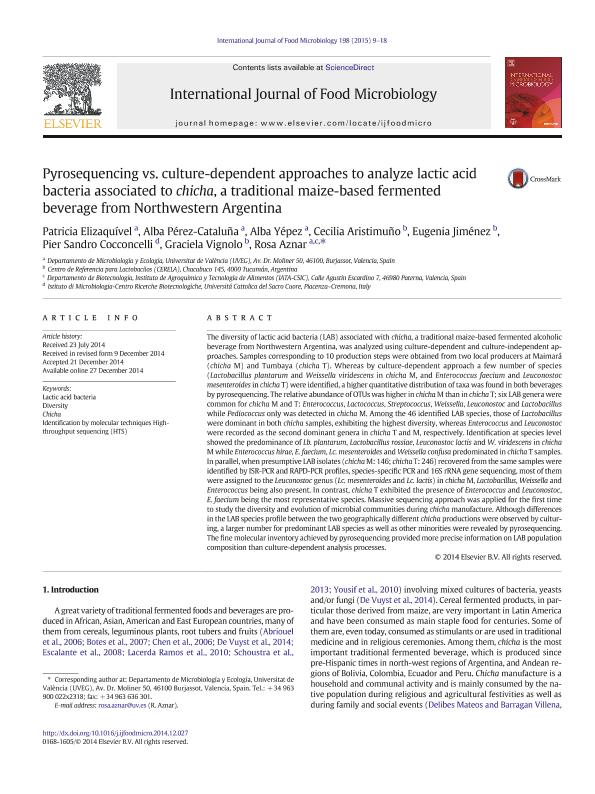Artículo
Pyrosequencing vs. culture-dependent approaches to analyze lactic acid bacteria associated to chicha, a traditional maize-based fermented beverage from Northwestern Argentina
Elizaquível, Patricia; Perez Cataluña, Alba; Yepes, Alba; Aristimuño Ficoseco, Maria Cecilia ; Jimenez, María Eugenia
; Jimenez, María Eugenia ; Cocconcelli, Pier Sandro; Vignolo, Graciela Margarita
; Cocconcelli, Pier Sandro; Vignolo, Graciela Margarita ; Aznar, Rosa
; Aznar, Rosa
 ; Jimenez, María Eugenia
; Jimenez, María Eugenia ; Cocconcelli, Pier Sandro; Vignolo, Graciela Margarita
; Cocconcelli, Pier Sandro; Vignolo, Graciela Margarita ; Aznar, Rosa
; Aznar, Rosa
Fecha de publicación:
02/01/2015
Editorial:
Elsevier Science
Revista:
International Journal of Food Microbiology
ISSN:
0168-1605
e-ISSN:
1879-3460
Idioma:
Inglés
Tipo de recurso:
Artículo publicado
Clasificación temática:
Resumen
The diversity of lactic acid bacteria (LAB) associated with chicha, a traditional maize-based fermented alcoholicbeverage from Northwestern Argentina, was analyzed using culture-dependent and culture-independent approaches.Samples corresponding to 10 production steps were obtained from two local producers at Maimará(chicha M) and Tumbaya (chicha T). Whereas by culture-dependent approach a few number of species(Lactobacillus plantarum and Weissella viridescens in chicha M, and Enterococcus faecium and Leuconostocmesenteroides in chicha T) were identified, a higher quantitative distribution of taxa was found in both beveragesby pyrosequencing. The relative abundance of OTUs was higher in chicha M than in chicha T; six LAB genera werecommon for chicha M and T: Enterococcus, Lactococcus, Streptococcus, Weissella, Leuconostoc and Lactobacilluswhile Pediococcus only was detected in chicha M. Among the 46 identified LAB species, those of Lactobacilluswere dominant in both chicha samples, exhibiting the highest diversity, whereas Enterococcus and Leuconostocwere recorded as the second dominant genera in chicha T and M, respectively. Identification at species levelshowed the predominance of Lb. plantarum, Lactobacillus rossiae, Leuconostoc lactis and W. viridescens in chichaM while Enterococcus hirae, E. faecium, Lc. mesenteroides and Weissella confusa predominated in chicha T samples.In parallel, when presumptive LAB isolates (chicha M: 146; chicha T: 246) recovered from the same samples wereidentified by ISR-PCR and RAPD-PCR profiles, species-specific PCR and 16S rRNA gene sequencing, most of themwere assigned to the Leuconostoc genus (Lc. mesenteroides and Lc. lactis) in chicha M, Lactobacillus, Weissella andEnterococcus being also present. In contrast, chicha T exhibited the presence of Enterococcus and Leuconostoc,E. faecium being the most representative species. Massive sequencing approach was applied for the first timeto study the diversity and evolution of microbial communities during chicha manufacture. Although differencesin the LAB species profile between the two geographically different chicha productions were observed by culturing,a larger number for predominant LAB species as well as other minorities were revealed by pyrosequencing.The fine molecular inventory achieved by pyrosequencing provided more precise information on LAB populationcomposition than culture-dependent analysis processes.
Archivos asociados
Licencia
Identificadores
Colecciones
Articulos(CERELA)
Articulos de CENTRO DE REFERENCIA PARA LACTOBACILOS (I)
Articulos de CENTRO DE REFERENCIA PARA LACTOBACILOS (I)
Articulos(SEDE CENTRAL)
Articulos de SEDE CENTRAL
Articulos de SEDE CENTRAL
Citación
Elizaquível, Patricia; Perez Cataluña, Alba; Yepes, Alba; Aristimuño Ficoseco, Maria Cecilia; Jimenez, María Eugenia; et al.; Pyrosequencing vs. culture-dependent approaches to analyze lactic acid bacteria associated to chicha, a traditional maize-based fermented beverage from Northwestern Argentina; Elsevier Science; International Journal of Food Microbiology; 198; 2-1-2015; 9-18
Compartir
Altmétricas



